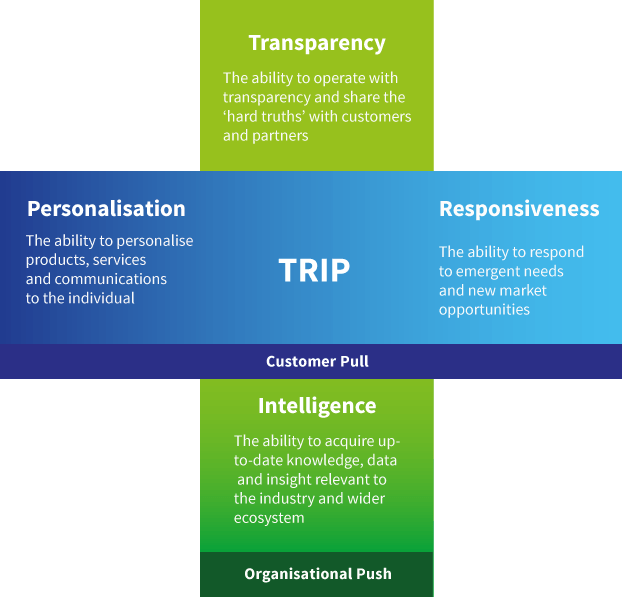By Mike Cooray and Rikke Duus
Across industries, organisations are in search of new ways to enhance their competitiveness in the midst of digital disruption and a changing competitor landscape. To guide organisations through the turbulent waters of the digital era, we need new frameworks to help shape organisational strategy and decision-making. In this article, we introduce a new strategising framework that is designed, developed and tested to support organisations to navigate and maneuver in digital spheres.
The nature of competition across many industry sectors is changing. Organisations that were traditionally archrivals are now driving innovation together through collaboration. This is prevalent in the automobile industry where new partnerships are forged between some of the industry’s strongest incumbent players, for example BMW and Mercedes, with a view to share resources to push forward new vehicle platforms, electric-car batteries and autonomous-driving technology. At the same time, born-digital organisations are seeking to disrupt entire ecosystems and destabilise the competitive landscape. In the automobile industry, Waymo, the autonomous vehicle unit of Google’s parent company, Alphabet, is making waves and recently1 launched a robo-taxi service in Chandler, Arizona, for people enrolled in its early rider programme (there is, though, still a human behind the wheel. Just in case!)
Due to the influx of digital technologies and changing business models, many incumbent organisations have struggled during the last five to ten years of digital transformation, failing to adapt to new industry dynamics, changing customer preferences and the speed of innovation.
To achieve and retain a competitive position, it is critical to look outside of the organisation’s core ecosystem and anticipate the emergence of competition from affiliated and ‘invisible’ sources. Many organisations do no longer align themselves according to a ‘core business’, but utilise their resources, capabilities and competences to stretch the organisational playing field across multiple industry sectors.2
Organisations are striving to become agile and responsive in order to play in emergent ‘white spaces’. To attain a flexible and adaptive organisational mindset, it is necessary to focus more on organisational ‘strategising’ than ‘strategy’. Organisational strategising reflects the doing and practice of performing and responding to an emergent environment, learning from past decisions and behaviours and adapting these to inform how to respond to future opportunities and challenges.3 Members of the organisation make use of their ‘practical mastery’4 to navigate new situations, relying on their tacit and embodied knowledge and experiences.
The TRIP Framework
In response to a complex, fast-changing and digitally-driven environment, we have developed the TRIP strategising framework. TRIP is useful for decision-makers across organisations and industry sectors to help assess, analyse and navigate their environment and identify new opportunities for value creation. TRIP consists of four dimensions: Transparency, Responsiveness, Intelligence and Personalisation. These are four core areas that all organisations, including incumbent and born-digital, need to be alert to and, when invested in, can help steer the organisation towards new white space opportunities.
The four dimensions interact to create a dynamic ‘Organisational Push’ and ‘Customer Pull’ effect. The two dimensions, ‘Transparency’ and ‘Intelligence’, are driven by the organisation (Organisational Push), seeking to enhance its competitive position through openness and sharing (Transparency), while also being proactive in advancing knowledge and insight of the immediate and augmented ecosystems (Intelligence). Thus, Organisational Push is primarily propelled by the organisation, while Customer Pull, through ‘Responsiveness’ and ‘Personalisation’, reflects new demands and expectations driven by the market. We propose that organisations will need to become flexible in their approach and willing to venture outside of their core business in order to respond to emergent needs and new opportunities (Responsiveness). At the same time, many organisations will also benefit from the ability to meet individual customer and stakeholder demands and preferences (Personalisation).
The TRIP strategising framework can be used effectively within organisations to ascertain current engagement and performance on these four important dimensions. This can be used as a foundation to re-imagine the organisation’s strategising approach for the medium- to long-term future.
While organisations may wish to focus on all four TRIP dimensions simultaneously, prioritising a single dimension from Organisational Push (Transparency or Intelligence) and Customer Pull (Responsiveness or Personalisation) can help those organisations, needing to move swiftly, focus on identifiable and actionable strategic initiatives.
[ms-protect-content id=”9932″]
Transparency
Transparency is critical when considering the strategic path of the organisation. With regulatory frameworks catching up with the digital revolution, customers and wider ecosystem partners are demanding organisations to possess and express a heightened level of transparency.
Customers and contributing partners of the organisation will increasingly demand transparency prior to deciding on their level of engagement. They will prefer to engage with organisations that adopt a clear-box approach to their business practices. In recent years, we have witnessed many leading organisations getting caught in the spotlight for their unethical and, sometimes, illegal actions. This includes senior executives of leading banks (e.g. Danske Bank), automobile manufacturers (e.g. Nissan, Audi and VW) and social media platforms (e.g. Facebook).
It is further critical for organisations to be open and transparent as gradually legislators will be looking deeper into unfair practices and more companies will become exposed. We see several examples of organisations, such as Google5, Apple and Qualcomm, being handed extensive fines and taken to task by the media for their actions. This underlines the urgency for organisations to revisit their business practices and proactively embrace organisational transparency.
A fundamental pillar of being a transparent organisation in the digital age is the approach to consumer privacy and data.6 In our recent research7 with individuals from GenTech (19 to 24-year-old digital technology users), we found that 54% are very concerned about the access organisations have to their data, while only 19% were not worried. More than 70% felt that too much of their data is in the possession of a small group of global companies, including Google, Amazon and Facebook. Thus, the digital native generation has begun to question and show scepticism towards the data-driven behaviours and business models of many organisations. This creates vital opportunities for new organisations with high levels of data transparency and user privacy options.
Transparency, not only, relates to how an organisation handles customer data, but also its adoption of sustainable and ethical business practices. We have already seen the emergence of organisations such as Ecosia (a non-profit search engine that diverts a proportion of its revenue to tree planting projects around the world), Bulb (renewable energy supplier), and Buffer (shares publicly information on salaries, investments and financial performance), build in transparency as part of the core organisational ethos. Other organisations and platforms, such as as CoGo and Zerowastenear.me, connect consumers directly with ethical and sustainable businesses.
Organisations should give thought to how they can obtain a higher level of transparency in the way they operate, communicate and participate in the wider society. We strongly believe that consumers and other ecosystem partners will soon demand a high level of transparency, and ethical and moral standing of organisations. Such enhanced state of transparency will no doubt create new competitive opportunities in current and emergent markets.
Responsiveness
The ability to respond to emergent needs and new opportunities is central to an organisation’s competitiveness. At a time when new needs are facilitated by digital technologies, the responsiveness of organisations will be the decider for their success or failure. We see organisations that are able to foresee and respond to emergent needs, aligning necessary competences and expertise to benefit from these new opportunities in digital spheres.
Being responsive means monitoring local and global trends that affect the organisation’s own industry and those to which it is affiliated. One of these global trends is the growth of urban environments, with 68% of the world’s population anticipated to live and work in cities by 2050.8 This will create significant opportunities for organisations and other contributors to respond to new citizen needs. We have already seen consumer habits change rapidly due to digitisation of consumption and the growth of consumer communities that drive opinions, behaviours and preferences. Concurrently, many industrialised nations will continue to embrace new technologies, including 5G telecommunications. 5G connectivity is expected to dramatically increase internet speed and coverage, which will help fuel the era of Internet of Things (IoT) as well as augmented and virtual reality.9
IKEA is an organisation that is continuously responding to social, cultural and technological change, adapting the form of the organisation to enhance its relevance. IKEA’s latest responses include the introduction of an IoT enabled smart lighting range, small-format shops in selected megacities to reach city consumers, partnering with TaskRabbit to offer customers easy and convenient help with furniture assembly, and developing a partnership with Big Clean Switch, a social business helping consumers to switch to green energy. However, we also see how IKEA is more fundamentally re-thinking their role and purpose as an organisation. Through their innovation hub, Space10, IKEA is experimenting with solar energy, micro-grids and blockchain technologies through the ‘SolarVille’ initiative. Their ‘Building Blocks’ initiative seeks to drive forward innovation for low-cost, adaptable, modular and sustainable homes to be manufactured locally. Clearly, IKEA is an organisation in strategising mode, challenging the status quo and proactively using technology to respond to new needs and aspirations.
To enhance responsiveness, organisations will need to embrace the practice of strategising that enables change of direction to pursue new and emergent opportunities. They should also review their need for new skills and competences with a more tech-enabled workforce, digitised operational systems that enable multiple internal and external partners to ‘plug in’, and learning and development strategies to ensure the organisational workforce is fuelled and ready to respond to the new demands.
Intelligence
Organisations that are transparent and responsive will march ahead to thrive in dynamic and digital environments. However, it is of critical importance that such organisations are also able to acquire cutting-edge knowledge, deep insight and reliable data and use this to design and execute new strategic initiatives. While there are reams of data available to organisations, this often creates ‘data clutter’, which leads to strategic confusion. Organisations also have the additional challenge of data quickly becoming historic, especially in fast-paced market environments.
We have seen both born-digital organisations and incumbents struggle to anticipate market and customer developments, losing sight of current and future trends. In many cases, this lack of intelligence has significantly harmed their organisational competitiveness. An example of this is the born-digital fashion retailer, Asos, which, despite much success since its launch in 2000 and a reputation for using digital technology to create innovative customer engagement, is now facing notable challenges. The company recently posted a near 90% drop in half-year earnings.10 This drop in performance is attributed partly to the cost associated with expansion of warehouses, and partly to decisions made in relation to pricing, marketing and inventory, which have led to a compromised customer proposition and a slowdown in customer acquisition11. As a way of regaining traction with consumers, CEO, Nick Beighton, announced that he will reinvigorate customer conversations and thereby gain better insight into the demands and aspirations of the customer base to realign the organisation’s offerings. This underlines how important it is to stay close to the market and have an on-going dialogue with customers as a way of enhancing the organisation’s intelligence.
Central to being an intelligent organisation also entails the ability to gather new knowledge and capabilities by working in collaboration with others. Often, an organisation will not possess all the skills, insight and capabilities needed to compete in highly competitive and digital spheres. Therefore, we see organisations enhancing their competitive position through partnerships and new collaborative value co-creation. One such company is TDC Group (leading Danish telecom company), which has initiated the creation of a dynamic ecosystem of SMEs and startups that develop new IoT devices and systems. TDC Group works directly with these companies to push forward cross-sector innovation and enhance their own IoT offering. All participants engage in learning and knowledge-sharing, enhancing their intelligence to support future innovation.
Personalisation
Personalisation has long been seen as the holy grail of many organisations’ strategic aspirations. Digital technologies are enabling organisations to create a point of differentiation through an ability to personalise their products, services, experiences and communications. Customers increasingly demand personalised products and services that meet their needs more precisely. With enhanced manufacturing, design and logistics capabilities, organisations are striving to personalise their products and services to gain a competitive edge. However, it is expected that personalisation will continue to be the ever-persistent strategic challenge across industries, including automobile, fashion, construction, healthcare, travel and financial services.
Many organisations, such as Vitality (insurance), L’Oreal (beauty and personal care) and Stitch Fix (fashion) are on a forward march to acquire, engage and sustain customers through personalisation, achieved through digital means. Personalising services, products and interactions can help to build relationships with customers and raise the perceived level of relevance.
Personalisation is, not only, a mode of engagement to be considered by private organisations. In the UK, the National Health Service (NHS) has developed a long-term plan for the implementation of universal personalised care12. In this context, personalised care considers the individual’s strengths, needs and preferences and gives citizens choice and control over how care is planned and delivered.
Personalisation at a large-scale is often facilitated by the use of digital technologies, including artificial intelligence, machine learning algorithms and artificial neural networks. These are powerful technologies that learn about behaviours and trends to enable predictions about future preferences and tendencies. Organisations that employ such increasingly advanced technology in pursuit of mass personalisation also have a significant responsibility to gain consent and be honest about how they gather, analyse and use individuals’ data.13
Once data is acquired to facilitate personalisation, organisations and institutions need to be able to protect it. Recent data breaches, such as that of British Airways14, Swisscom15 and SingHealth16, clearly demonstrate that protecting sensitive data is an on-going struggle, even for large resourceful organisations.
Conclusion
TRIP is a distinctive strategising framework that is designed to assist organisations operating in digital spheres to enhance future competitiveness. The versatility of this framework is the ease of use for managers and strategists, being able to measure and ascertain the current performance of each TRIP dimension and identify how to shape, align and drive future organisational action. These actions can include, but are not limited to, competence building, initiation of collaboration with internal and external partners, and identification of specific investment needs and opportunities. Used effectively, the TRIP framework can help organisations enhance their relevance, adaptability and identify new white spaces to reach and occupy in digital spheres.
[/ms-protect-content]
About the Authors
 Dr Mike Cooray is a Professor of Practice at Ashridge Executive Education at Hult International Business School. Mike is an Academic Director and contributes to several Executive and Masters programmes in London, Dubai and Shanghai. He designs and delivers programmes in digital strategy, customer behaviour and business transformation. He has previously worked with Carlsberg, Mercedes-Benz and Siemens.
Dr Mike Cooray is a Professor of Practice at Ashridge Executive Education at Hult International Business School. Mike is an Academic Director and contributes to several Executive and Masters programmes in London, Dubai and Shanghai. He designs and delivers programmes in digital strategy, customer behaviour and business transformation. He has previously worked with Carlsberg, Mercedes-Benz and Siemens.
 Dr Rikke Duus is senior faculty at University College London, School of Management, and visiting faculty at ETH Zurich. Rikke’s area of expertise is in digital transformation, dynamic organisations and human-tech relationships. She frequently presents at international conferences and events and is widely published in leading global media outlets.
Dr Rikke Duus is senior faculty at University College London, School of Management, and visiting faculty at ETH Zurich. Rikke’s area of expertise is in digital transformation, dynamic organisations and human-tech relationships. She frequently presents at international conferences and events and is widely published in leading global media outlets.
References
1. Davies, A. (2018). Waymo’s so-called robo-taxi launch reveals a brutal truth. Wired. Online: https: / / www.wired.com / story /waymo – self – driving – taxi – service – launch – chandler – arizona /
2. Cooray, M. and Duus, R. (2016). Putting new age organizations on ‘ICE’. World Economic Forum. Online: https://www.weforum.org/agenda/2016/07/putting-new-age-organizations -on-ice /
3. Whittington, R. (2011). The practice turn in organization research: Towards a disciplined transdisciplinarity, Accounting Organizations and Society, 36(3), 183–186.
4. Tsoukas, H. (2005). Complex knowledge. Oxford: Oxford University Press.
5. European Commission (2019). Antitrust: Commission fines Google €1.49 billion for abusive practices in online advertising. Online: http://europa.eu/rapid/press-release_IP-19-1770_en.htm
6. Duus, R. and Cooray, M. (2015). The importance of open data. World Economic Forum. Online: https://www.weforum.org/ agenda / 2016/02/the – importance – of – open – data/
7. Cooray, M. and Duus, R. (2019). Revolt on the horizon” How young people really feel about digital technology. The Conversation. Online: https://theconversation.com/revolt – on – the – horizon – how – young – people – really – feel – about – digital – technology – 117209
8. United Nations (2018) Department of Economic and Social Affairs. Online: https://www.un.org/development/ desa/en/news/population/2018-revision-of-world-urbani- zation-prospects.html
9. World Economic Forum (2019). Realizing the Internet of Things: A Framework for Collective Action. Online: http://www3.weforum.org/docs/WEF_Realizing_the_Internet_of_Things.pdf
10. Eley, J. (2019). Asos profits shrivels in ’disappointing’ half. FT. Online:https://www.ft.com/content/30e9c240-5b56-11e9-9dde-7aedca0a081a
11. Vizard, S. and Hammett, E. (2019). Asos ’upweights’ digital spend as it puts focus on acquisition. MarketingWeek. Online: https://www.marketingweek.com/2019/04/10/asos-digital-marketing-spend/
12. NHS (2019). Universal Personalised Care. Implementing the Comprehensive Model. Online: https://www.england.nhs.uk/wp-content/uploads/2019/01/universal-personalised-care.pdf
13. Yeung, K. (2018). Five fears about mass predictive personalization in an age of surveillance capitalism. International Data Privacy Law, 8(3), 258–269.
14. British Airways (2018). Customer data theft. Online: https://www.britishairways.com/en-gb/information/incident/data-theft/latest-information
15. Baur, R. (2018). Interview with Philippe Vuilleumier. Swisscom. Online: https://www.swisscom.ch/en/about/medien/news/interview-philippe-vuillemier-head-group-security.html
16. BBC (2018). Singapore personal data hack hits 1.5m, health authority says. Online: https://www.bbc.co.uk/news/world-asia-44900507





































